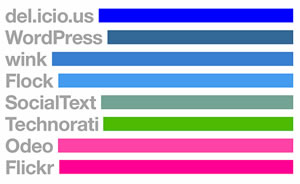Web 2.0
Web 2.0 doesn't have a hard boundary, but rather, a gravitational core. You can visualize Web 2.0 as a set of principles and practices that tie together a veritable solar system of sites that demonstrate some or all of those principles, at a varying distance from that core.
- Tim O'Reilly, "What Is Web 2.0?"
Service, Adaptability, and the Centrality of the User
Web 2.0 is not a program. Web 2.0 is not an application. Web 2.0 is not a tool. Web 2.0 is a combination of ideas, values, methods, and principles for web production and use. Web 2.0 is an emerging technical and social idea that is founded around a core of principles and practices of the web - which are discussed in more detail in each section: Web Services, Collective Intelligence, Really Simple Syndication, Lightweight Programming, Rich User Experience, and Digital Lifestyle Aggregation. Overall, the aspects above are valued in Web 2.0 for their dynamic and collaborative abilities. At the heart of the idea of Web 2.0 are “service”, “adaptability”, and the “centrality of the user”.
The Web 2.0 Conference was birthed with the brainstormed idea of “Web 2.0” and has met annually since 2004. It is sponsored by O'Reilly Media, Inc. and MedaLive International to discuss topics such as the web as an operating system, media distribution, mobile communication, and creativity in order to further understand the emerging ideas of Web 2.0.
Here is a brief introduction to each of the listed core principles and practices:
Web Services: the web can be viewed as a large computer platform or “webtop” (instead of a “desktop” or “laptop”) by using technology such as XML to communicate between the Web and the user's computer. Google.com seeks to provide multiple services to users through their integrated web-based tools.
Collective Intelligence: user participation adds value. Wikipedia.org is an online, open collaboration of users creating and editing a database of information.
Really Simple Syndication (RSS): a method of creating a dynamic, “live” web through syndication, simultaneously making content available in a range of outlets. Blogs are becoming commonly syndicated, open conversations, and exchanges of ideas that are interlinked and are “organically” growing.
Lightweight Programming: the intentional use of open source programs – such as SOAP and REST – for the creation of web content allows for programs to be tailored by users and applied in new ways. Amazon.com uses open “application programming interfaces” (APIs) and allows for other users to link to their database for new uses and integrations.

"The Colors of Web 2.0", Made by Chris Messina. Some rights reserved.
Rich User Experience: the creation of graphical user interfaces, that use semantic markup – programming that describes content (XHTML) and attaches external styling (Cascading Style Sheets, CSS) to that content for the visual look – and AJAX integrated applications on the web that act and look like computer applications in order to increase the use and accessibility. Gmail.com and Flickr.com are easy to use, web-based applications for the viewing, creation, and sharing of data and media.
These are a few of the memes/ideas that overarch and infuse the values of Web 2.0. The Meta-Meme of Web 2.0 is just that, a constantly changing, dynamically connected, expansive dialogue and interconnected web of functions and uses. These ideas are affecting many of our lives today and have great potential for the future of the web and individuals' use of technology.
» Next: WEB SERVICES/ GOOGLE.COM